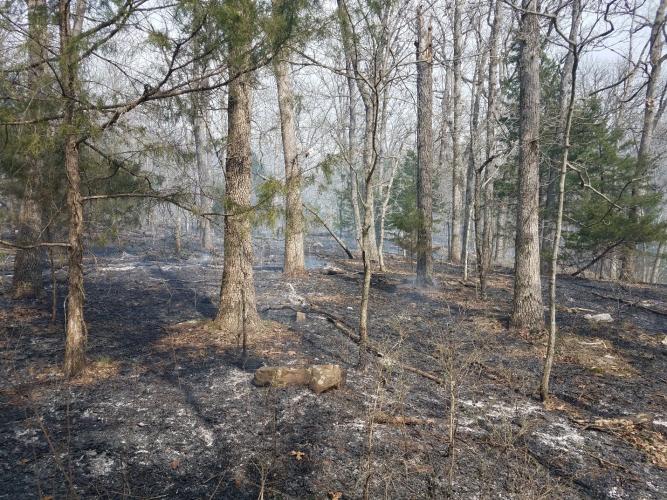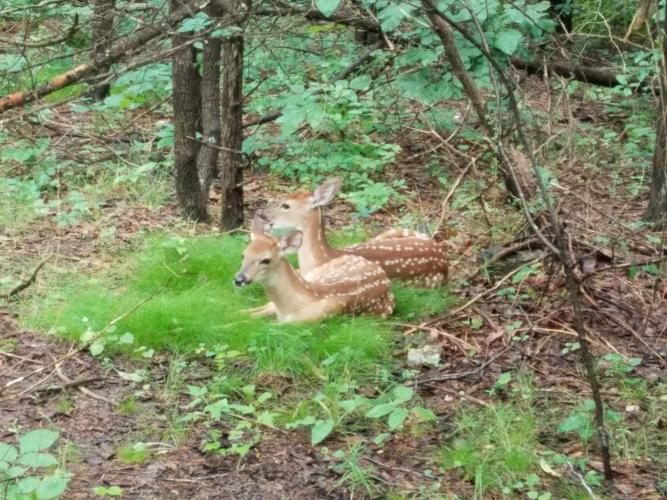The Little Niangua River area is the most diverse stream system on the border of Missouri’s Upper Ozark Highlands. The 240-acre Little Niangua River Natural Area is a prime example of the high-quality natural communities (habitats) within this watershed. It features more than a half mile of river with adjacent woodlands, bluffs, and glades. Sixty-one species of fish and 15 species of mussels have made the river their home.
This geography encompasses 185,000 acres (5,000 acres of public land and 180,000 acres of private land). MDC and conservation partners are engaging Missouri citizens to cooperatively manage natural resources across this landscape to enrich the local economy and quality of life. Many private landowners are already working with us to improve the quality of water, habitat, and working lands on their properties.
You can visit Mule Shoe, Burnt Mill Cave, and Fiery Fork conservation areas to see examples of managed habitats such as forests, woodlands, glades, and stream banks.
Contact our Lebanon Office to speak with a member of our dedicated team.
MDC staff can provide:
- Cost-share information
- Lists of contractors
- Guidance for timber sale administration
- Guidance on grazing and pasture management
- Advice for sustainably growing and harvesting timber
- Step-by-step recommendations for improving wildlife habitat
Title
What Conservation Practices Could Benefit Me?
MDC’s aim in priority geographies is to find common sense solutions to meet the goals of local landowners while balancing the needs of nature. Our staff and partners will work with you to create a program that fits your property goals with the conservation practices that are right for you. In the Little Niangua River area, these practices may include:
- Streambank stabilization and reinforced stream crossings
- Livestock watering systems
- Tree and shrub planting
- Fencing to protect sensitive areas from livestock
- Timber stand improvement
- Native grass and wildflower seeding
- Invasive species removal and control
Title
How Will The Area Benefit From Conservation Efforts?
- Healthier forests and woodlands
- Improved water quality
- Open glades with an amazing diversity of wildflowers and animals
- Stable stream banks with reduced soil erosion and healthy riparian corridors (trees/shrubs/grasses bordering streams)
- Reduced number of invasive plants such as autumn olive and sericea lespedeza
Title
What Species Will Be Helped?
While all species will benefit — including game animals — key species and species of greatest concern in the Little Niangua River area include:
- Birds: wild turkey, cerulean warbler, common yellowthroat, eastern wood peewee, hooded warbler, Louisiana warbler, orchard oriole, prothonotary warbler, wood duck, wood thrush, yellow-throated warbler, yellow-throated vireo
- Amphibians: Blanchard’s cricket frog, pickerel frog, wood frog, ringed salamanderC, four-toed salamanderC, eastern narrow-mouthed toad, spotted salamander, marbled salamander
- Reptiles: western spiny softshell turtle, common map turtle, red-eared slider, western cottonmouth, northern water snake
- Mammals: white-tailed deer, gray bat* **, muskrat, mink
- Insects: tiger beetle, pipevine swallowtail, tiger swallowtail, native bees
- Mussels: flat floater, Ozark pigtoe, western fanshell
- Fish: banded darter, banded sculpin, hornyhead chub, logperch, Missouri saddled darter, mottled sculpin, Niangua darter*, northern hog sucker, Ozark minnow, slender madtom, smallmouth bass
- Plants: cardinal flower, shining blue star, vernal witch hazel, golden glow, hazelnut, nine bark, river birch, river oats, tall bellflower, Virginia bluebells, Virginia wild rye, oaks, hickories
C = species of conservation concern, * = state endangered, ** = federally endangered


































